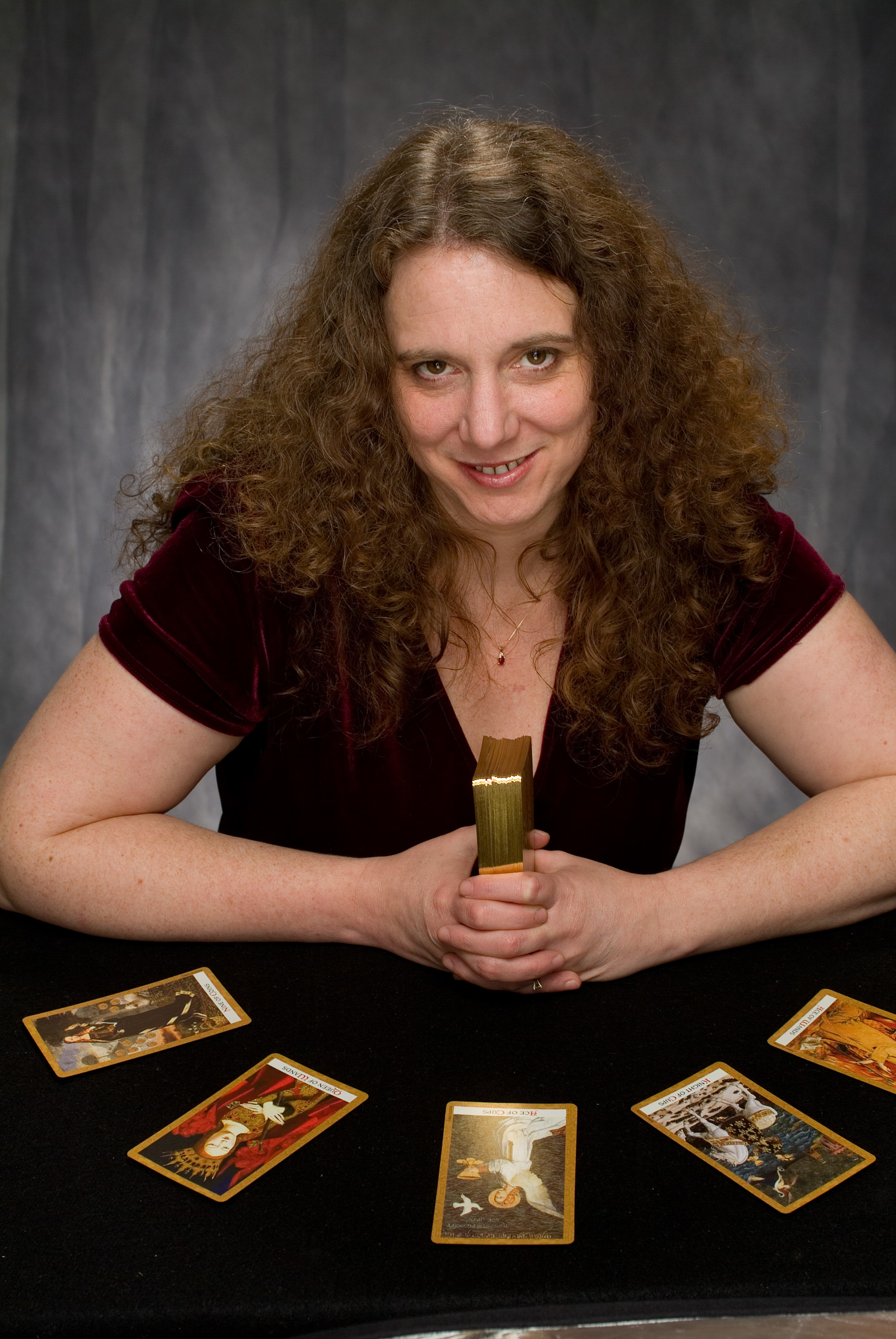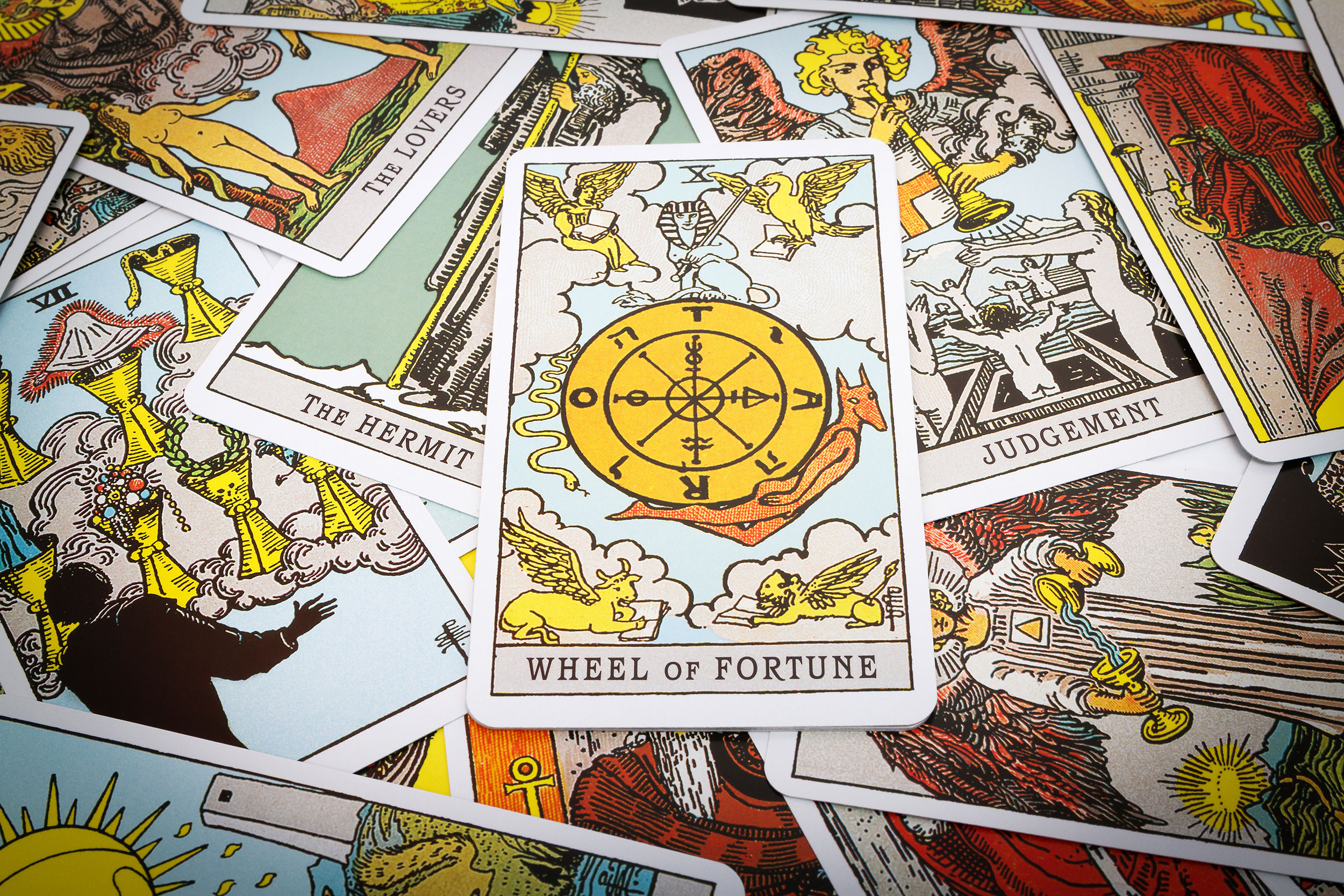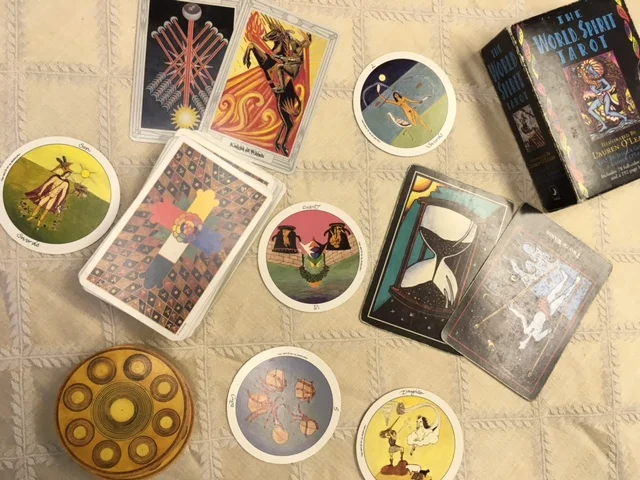
Welcome to my personal blog.
Here you will find my musings, thoughts and observations, all inspired by my experiences as a full-time professional tarot reader.
Musings on the Wheel of Fortune
Some thoughts on the Wheel of Fortune.
Something I love about tarot is that any of the seventy-eight cards can provide hours of entertainment and inspiration when we choose to ruminate upon it, research it, observe it closely and meditate on it.
Recently I’ve been fascinated with Major Arcana 10, the Wheel of Fortune.
One of the things I first considered is that the term, “Wheel of Fortune” exists beyond tarot. Was the title of the famous game show inspired by tarot, or is there an older reference to which both Vanna White and tarot owe gratitude?
It seems the concept of a universal wheel originated in Babylon and was developed by the ancient Greeks. The concept of the “Wheel of Fortune” was patterned after the zodiac. It’s interesting to note that ancient Indian art includes a thematically similar “Wheel of Becoming”.
In the medieval philosophy that birthed tarot the Wheel of Fortune (or Rota Fortunae) belongs to the Goddess Fortuna (Tyche) who spins the wheel randomly, causing fortunes to be won and lost.
In the Waite-Smith depiction, we see the words “tarot” and “rota” made of the same letters within the wheel. The Four Evangelists grace the four corners, as they do in the World card. Here, however, they are actively writing their gospels.
My favorite depiction of the Wheel of Fortune is from World Spirit Tarot, where humanity is bound to the wheel turned by the Gods.
While the age of the combustion engine has conflated wheels with transportation and forward motion, there continues to be a spiritual sense of the symbol of the wheel in popular culture. When I think of tarot’s Wheel of Fortune, I often think of two songs; Spinning Wheel by Blood, Sweat and Tears, and The Wheel, by the Grateful Dead.
There is a certain quality in tarot cards that causes them to behave in a reading much like their classic meaning. The very nature of the Wheel of Fortune is uncertainty and lack of control. Sometimes the message of this card is that anything can happen. In a reading, very often there is a sense that the Wheel of Fortune, due to its capricious nature, could mean anything at all.
When I lived and worked near large casinos, the Wheel of Fortune very often meant visiting the casino, working at the casino, or even developing a gambling addiction.
Recently, I have seen the Wheel of Fortune appear to discuss repetitive cycles, especially in habits and relationships. The Wheel of Fortune can describe the on-again, off-again cycle of a couple who keeps breaking up and getting back together. The Wheel of Fortune can describe the cycle of an addict who keeps getting clean but then falling off the wagon. I have seen the Wheel of Fortune appear for those struggling with bipolar disorder.
At the same time, when well-dignified I often see the Wheel of Fortune as a go-ahead from the Universe to take a risk and know that luck will be with you.
Sometimes I see the Wheel of Fortune as a reminder that no one is better off or worse off than anyone else; we all have our ups and downs.
Once, on the Upper East Side of Manhattan, the Wheel of Fortune appeared to me as I stared at a round church stained glass window, grappling with my mother’s terminal cancer as she was being treated at Memorial Sloan Kettering. Its message was a clear comfort; this is part of life, it’s not your fault, it’s the circle of life (cue Elton John and the lions).
When we contemplate a tarot card deeply, we reveal new avenues for interpretation. My deep contemplation of the Wheel of Fortune has led me to take my time with this card when it appears in a reading. As card Ten it carries the energy of One, offering new opportunities and beginnings, and cautions against repetitive cycles. The Wheel of Fortune is associated with Jupiter, which deals with both luck and law, but tends toward tolerance and expansion.
When the Wheel of Fortune predicts the future, you might interpret it as anything can happen, or that nature will take its course. At the same time, it can comfort you with the knowledge that, even in dark times, luck is on your side.
Further Reading
Community blog
Personal Blog
Reversals, Dignities and the Continuum of a Card
This month, the Tarot Rebels Blog Hop is writing about tarot reversals. I have a lot to say!
I’m blog-hopping with the Tarot Rebels again. This month, our meaty topic is reversals, about which I have much to say.
To read what other bloggers have to say on the topic, follow the link in the graphic at the end of this post!
I’m excited for the opportunity to share why I use reversals, how I interpret reversals, and why dignities matter, even if a reader chooses not to honor reversals.
Some decks, most significantly the Crowley-Harris-Thoth, specifically are not designed to work with reversals.
Rebel that I am, I will consider reversed cards even when reading with such a deck.
I love the energy, magick, possibilities and nuances of reversals so much that, secretly, I feel like readers who don’t honor reversals might be missing an opportunity.
There. That’s my dirty secret.
I absolutely honor each reader’s unique reading style, and recognize that reversals are not mandatory to give a great reading or deliver a sacred message. BUT, deep in my heart, I always secretly wonder if a refusal to use reversals might limit the scope and breadth of the reading.
That’s because reversals add so much to my readings. Truth is, we have other ways of adding texture to our stories. Card dignities and aspects are real, whether we use reversed cards to denote them, or not.
Dignities, or “aspects”, describe the energy with which a card should be read. A “well-dignified” or
“well-aspected” card’s energy is interpreted as directly as possible. If a card is poorly aspected, or ill-dignified, we might see a delay, a resistance, an opposite, or a release. The poor aspect might advise us not to take the action the well-dignified card would advise. The ill-dignity might put the event or action of the card in the past.
I use card orientation (reversals) as a primary way of determining dignity. If one doesn’t honor reversals, dignity is determined using the rigorous system of Elemental Dignities, or by more fluid and intuitive methods.
We might consider the context of the question and the surrounding cards when determining the directness with which we will interpret a card. The nature of the position within a spread plays, too. For instance, a “crossing” or “challenge” position always requires us to look for the shadow side of the card that appears within it.
Some readers use only intuition to decide if they are seeing the gift within a card, or its shadow; whether the card should be read directly, or in a more nuanced way. I would argue that we all do this, regardless of any more mechanical means we might use to denote dignity in a reading.
You can tell a reversals enthusiast by the way we shuffle. Readers who don’t use reversals shuffle in ways that try to avoid reversing cards. I riffle, and purposely turn half the deck around before each riffle, to make sure the Universe has the opportunity to add reversals to the language of tarot when needed.
My love of reversals may have begun with my second tarot deck, the Motherpeace Round Tarot. Since the cards are round, they are read on the tilt. Tilting in one direction indicates a resistance of the energy. The other direction indicates forcing. The depth of the tilt indicates he amount of resistance or force.
At the same time that I was learning to read with Motherpeace (some thirty years ago), I was mastering my very first deck, the trusty old RWS in the yellow box. I was using Eden Gray’s Complete Guide to the Tarot, and she had some very specific ideas of how to interpret reversals. To this day I remember that her Hierophant reversed is a “hippie”, and her High Priestess reversed is a “woman of low virtue”.
It was that combination of tilted round cards and Gray’s specific references that melded together to form my early vision of reversals.
Over time, my vocabulary for interpreting reversals has increased, primarily through the function of seeing so many reversals over the years, and understanding the specific ways they can speak to me.
One of the reasons I like reversals is that they can be a call to action. When I see a card like the Ace of Wands reversed, for example, I might see that my client is not in their full enthusiasm or vitality. I might specifically say that we need to “turn that around”. I might even physically turn the card right side up on the table. The righting of a reversal, or the reversing of a difficult upright card, is what Rachel Pollack calls a “magical act”. I agree.
When I see the Sun reversed, righting it might allow my client to really shine, or to truly embrace happiness. When I see the Devil upright, reversing it might allow my client the strength to release an addiction.
My understanding of reversals increased, ironically, when I studied a deck that specifically doesn’t honor reversals, World Spirit Tarot. The deck authors share that each card is a continuum; each card has gifts and shadows. They feel that we need to consider the gifts and shadows of each card every time it appears.
I loved that concept when I first heard it, and I love it still. However, for me, the reversal helps me find the gift in a difficult card, or the shadow in a usually-welcome card.
If you are new to reversals and want to give them a try, or if your current method of working with reversals isn’t working for you, try this.
When you see a reversed card, first allow yourself to feel it intuitively. Sometimes that is all you need. What does the card feel like in the moment? To process further, think about what you see visually. How does the reversal affect the picture? Might the reversal allow something good to happen, or might it make a Knight fall off his horse?
Then, think about the direct energy of the card, and the way that energy might be diminished. In my experience, reversals very often do at least one of the following:
- Indicate delay (event will not happen quickly)
- Indicate resistance (querent doesn’t like/want the energy of the card)
- Indicate an opposite
- Indicate a slight lessening
- Advise that an action not be taken
- Make a less desirable component of the card more predominant (Emperor becomes overlord, Magician becomes trickster, for example)
- Indicate a change to whatever the card implies (Four of Wands, when reversed, could indicate divorce, for example. Three of Swords reversed could indicate healing)
- Place a particular event in the past.
In my reading style, reversals have a special power when it comes to Court Cards. For me, all sixteen Court Cards will indicate people who are expressing the most positive aspects of their elements. When reversed, these people are reflecting the less positive aspects of their elements.
For example, Wands people are active, warm and creative. When reversed, they become dull, boring and lazy.
Speaking of lazy, I used to think that readers who don’t honor reversals make that choice out of laziness.
Upon further reflection, I think I may be the lazy one. For me, the reversal is such a simple way of adding clarity to a single card, a spread or an entire reading.
The Four of Swords reversed is a bitch-slap from the Universe for me, telling me to get off my butt and get busy.
The Ace of Wands reversed may nudge me to gently ask my client about problems in the bedroom.
The Ace of Swords reversed may tell me to turn up the intensity and volume in a marketing campaign.
When we go to the cards for magick rather than divination, we can dramatically turn a card on our altar to create a release or needed change. I wouldn’t send the Three of Swords to my sick friend, but I would use the Three of Swords reversed in a healing spell.
For me, an understanding of reversals forces a greater understanding of each card’s many voices, and offers an enhanced opportunity to receive specific messages, and to manifest specific energies.
Thanks for sharing this exploration of reversals with me! Now, follow the link in the graphic below, and hop over to read the other contributions on this topic.






